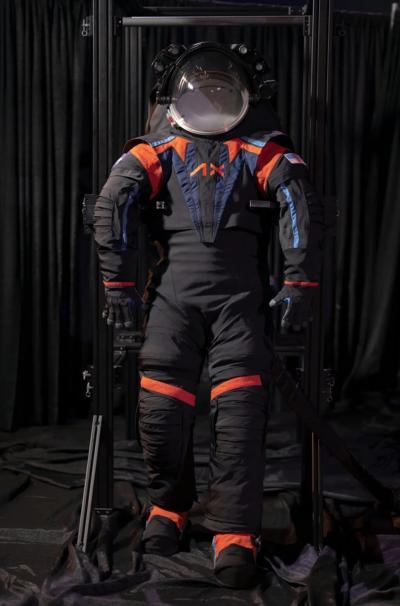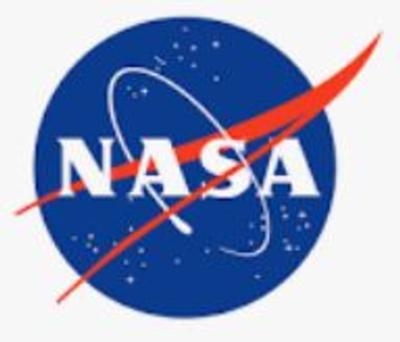Dressed Up Like a 3.5-Billion-Dollar Trooper …
Axiom Space, the Houston-headquartered, American, privately-funded space infrastructure developer, has made public its new space-suit design—a sleek, black, orange, and blue ensemble to be worn, more or less, by NASA astronauts as they explore the Lunar south pole during the space agency’s planed 2025 Artemis III mission.

NASA officials praised the complex habiliment in which humanity will return to the moon after a 51-year hiatus. Speaking at the suit’s unveiling, agency associate administrator Robert D. Cabana stated: “We’re developing a spacesuit for a new generation,”
The Axiom Space lunar suit is a critical component of NASA’s ambitious Artemis program and among the technological means by which the United States seeks to remain at the forefront of space exploration—even as Russia and China hasten to advance the aims of their respective space sectors.
During a presentation at Houston’s Space Center, Axiom engineer James Stein demonstrated the new lunar suit’s extraordinary flexibility and range-of-motion, kneeling, squatting, and moving about with a degree of ease vastly beyond the purview of legacy space-suits.
The Axiom suit’s helmet system comprises an expansive acrylic face-piece conducive to wholly unobstructed forward and peripheral vision. The helm is framed about its upper hemisphere with an array of powerful lights and a high-definition camera—features likely to prove eminently useful among the lunar south pole’s deeply shadowed craters, the bottoms of which are suspected to contain water ice.
Unlike NASA’s legacy space suits, which comprise numerous separate components and are donned after the cumbersome style of deep-sea immersion diving rigs, Axiom’s lunar suit is accessed via a large posterior hatch.
Axiom Space extravehicular activity deputy program manager Russell Ralston explained: “You would put your feet in, put your arms in and then kind of shimmy down into the suit; and then we would close the hatch.”
Referring to the backpack-like contraption containing the suit’s life support system, Mr. Ralston continued: “You can think of it as a very fancy scuba tank and air-conditioner, kind of combined into one.”
For all its slick looks and pliability, the prototype presented at the Houston Space Center differs from the suits in which NASA astronauts will embark upon the lunar frontier. For purpose of better-regulating thermal-dynamics, the actual moon suits will be white. What’s more, the Artemis III suits will sport additional outer layers of insulation by which wearers will be protected from extreme temperatures, lunar dust, and solar radiation.

Formerly NASA’s program manager for the International Space Station (ISS), Axiom Space co-founder, president, and CEO Michael Suffredini has plied his company’s resources primarily to Low Earth Orbit (LEO) endeavors such as dispatching private astronauts to the ISS and building a private module to be added to the space station. A variation of Axiom Space’s Lunar suit could be used to construct and maintain a private space station the company is considering.
Outsourcing the development of space-suits is a radical deviation from NASA’s longtime convention of designing, producing, vetting, and deploying its own extra-atmospheric garb. The agency spent years and hundreds-of-millions of dollars evolving its Exploration Extravehicular Mobility Unit, or xEMU—a space-suit architecture that was to replace the aging units in use on the ISS and facilitate future lunar missions.
Speaking to the subject of the xEMU, NASA Johnson Space Center director Vanessa Wyche stated: “We have not had a new suit since the suits that we designed for the space shuttle, and those suits are currently in use on the space station. …So forty-years we’ve been using the same suit based on that technology.”
In 2019, NASA officials showed off a prototype xEMU in a patriotic red, white, and blue livery, excitedly touting the suit’s preeminence and promulgating its flexibility.
“You remember Neil Armstrong and Buzz Aldrin,” then NASA’s administrator Jim Bridenstine enthused at the 2019 event. “They bunny-hopped on the surface of the moon. Well, now we’re actually going to be able to walk on the surface of the moon, which is very different than our suits in the past.”
Regrettably, a 2021 audit conducted by NASA’s inspector general concluded the xEMU would not be ready for fielding until April 2025—at the earliest. By the time of the audit’s release, NASA had begun soliciting space-suit concepts from the aerospace industry.
In June 2022, NASA selected two companies, Axiom Space and Collins Aerospace—the only concerns to submit completed bids for the contract—to build the agency’s future spacesuits. Through their 2034 durations, the contracts are worth up to $3.5-billion for the two companies.
In September 2022, Axiom won the award’s first installment—$228-million for the development of the lunar suit.
In addition to prescribing the lunar suit’s specifications, NASA afforded Axiom Space access to data and expertise germane to past space-suit designs, to include the xEMU. Notwithstanding lavish outlays of taxpayer dollars, Axiom Space will retain ownership of the lunar suits even as NASA astronauts lark about the moon’s surface therein.
“Think of it more like a rental car,” suggested Lara Kearney, who oversees NASA’s spacesuit program. “So Axiom will be providing the hardware for both training and for flight. They will bring that hardware in, and we, NASA, will utilize it and operate it on the surface of the moon for our moonwalking.”

Axiom Space officials concede that fully half of the company’s lunar suit design is based on NASA’s xEMU—to include the ensemble’s boots, helmet bubble, and upper torso.
Mr. Ralston set forth: “NASA put a tremendous amount of effort into designing that hard upper torso. We’ve tweaked a couple of minor details, but in large part that’s something that was a direct transfer.”
Axiom Space’s lunar suit will fit a broader spectrum of human bodies than current space-suits.
“We have different sizes of elements that we can swap out—a medium, large, and small, if you will—for different components,” Mr. Ralston stated. “But then, within each of those sizes, we also have an adjustability to where we can really tailor the suit to someone—the length of their leg or the length of their arm or things like that.”
 ANN's Daily Aero-Linx (04.15.24)
ANN's Daily Aero-Linx (04.15.24) Classic Aero-TV: 'No Other Options' -- The Israeli Air Force's Danny Shapira
Classic Aero-TV: 'No Other Options' -- The Israeli Air Force's Danny Shapira Aero-News: Quote of the Day (04.15.24)
Aero-News: Quote of the Day (04.15.24) Airborne 04.16.24: RV Update, Affordable Flying Expo, Diamond Lil
Airborne 04.16.24: RV Update, Affordable Flying Expo, Diamond Lil ANN's Daily Aero-Term (04.16.24): Chart Supplement US
ANN's Daily Aero-Term (04.16.24): Chart Supplement US





